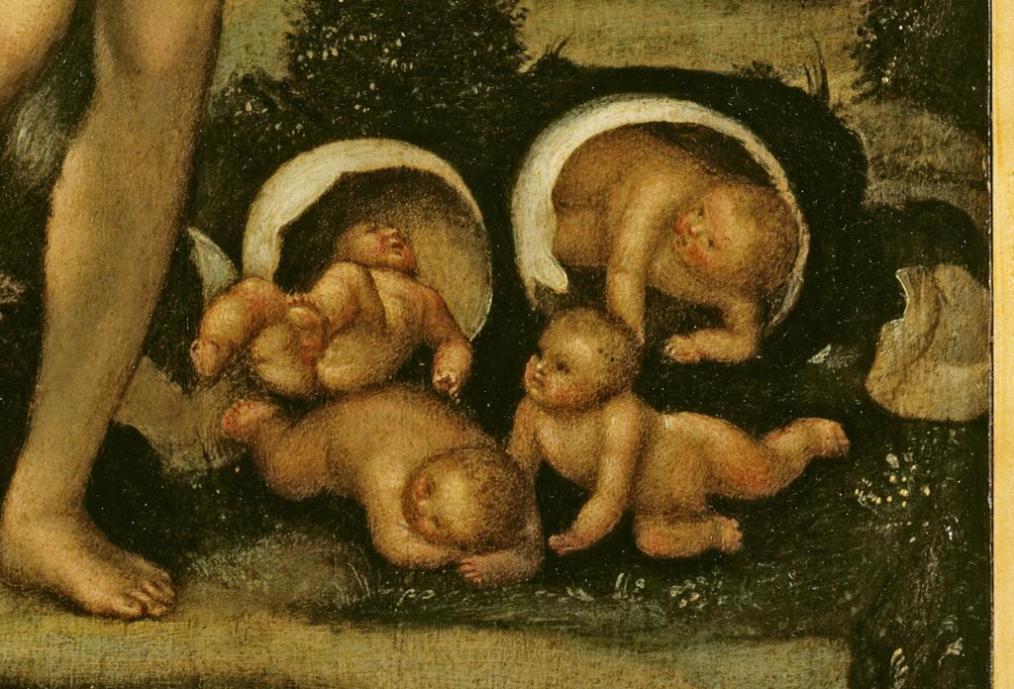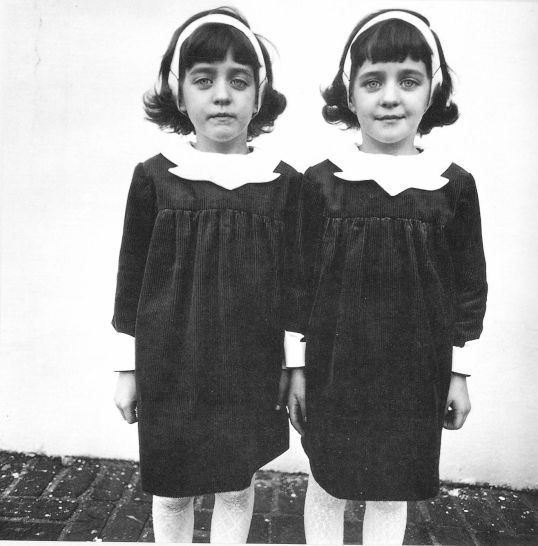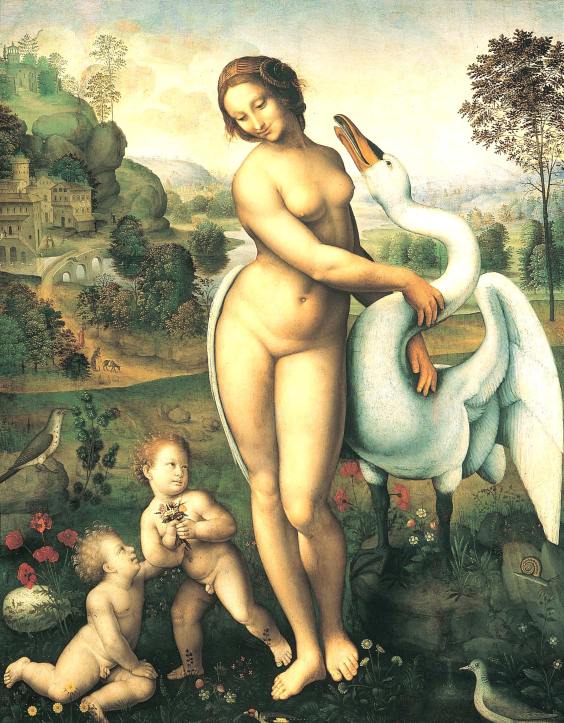With over 140 twin registries in the world, carrying biometric data of hundreds of thousands of twin sets, twins have assisted in the major breakthroughs in behavioural genetics and genetic epidemiology in the last 20 years. In my recent interviews with medical practitioners, twins have been described as “more clone than clones”, a “naturally occurring experimental situation” and offering a “unique insight” into our genetic make up and the way in which we are effected by our environment.
This is a more recent, scientific aspect to the long history of twinly contemplation. I want to outline some of the other imaginative structures, the philosophical, theological and medical perspectives, which have kept twins in what might be called ‘exceptional states’ , keeping them in a long history of curiosity and wonderment. Doing so, we might, at some point, be led back to the scientific interest in twins with fresher opinions about their significance. We might even have something interesting to say about how scientific research works to isolate ‘everyday laboratories’ in the hope of bringing experimental and observational cultures into closer alignment.
I. Separated at Birth
In their conception, gestation, birth, early development, adolescence and adulthood, in life and in death, twins have been separated from those born alone. A central hypothesis of my work is that, for us to tell the story of twins and their significance in human history, we must reckon with this separation. I argue that, to tell twins together, to narrate a genealogy of their peculiar powers, we encounter the perennial problem of telling twins apart.
From ancient myth to contemporary genetics, twins are refused and often refuse to be entirely at one with a world largely populated by those born alone. My research is shaped by some wide historical parameters but limited by the biological and numerical oddity that twins present to us. I’m struck by how identical, or monozygotic twins (MZ) occur, roughly, once in every 285 births. They are, one might say, statistically routine, indeed, the rate of fraternal or dizygotic twin (DZ) births varies from place to place and form culture to culture, but population studies have shown that the rate of identical twin births remain relatively stable across time and place: 1 in every 285. Yet, and perhaps because of this statistical regularity, we still tend to find twins intensely odd. Although multiple births are extremely common, if not the norm in mammals, the relative rarity of human twinning gives multiple human births a sense of abnormal superabundance. Twins are utterly like us in every biological sense but, by so closely sharing genetic material and pre- and, more often than not, post-natal environments, they are in no way like us at all. It’s this rather simple intuition, this elastic relation between ‘us’ and ‘them’, the one and the multiple, that binds twins together and sets twins apart from singletons.
But it is not enough, I think, to simply observe that twins are different for being two. Twins are frequently used as a shorthand for human symmetry, similitude, mirroring and the erasure of difference between people. To say ‘he is my twin’ or ‘she is as a twin to me’ is to claim an intense intimacy or physical likeness. Twins, then, are a minority group and a naturally occurring community of unreasonable duplicates, twice-born clones, egg-splitting doubles, that have taken majority stakes in the history of human self-regard.[1] For these and other psychosocial reasons, the sociologist Elizabeth Stewart has argued that twins are not simply one, not simply two, but “supra-individual unit[s]”[2], units not easily delineated into their component parts.[3]
The consequences of this exceptional, separated togetherness of the twin, echo throughout the stories that represent them, in the twin myths that revolve around conditions of remarkable similitude, in the emerging natural orders of wonder that govern scientific inquiry, in the countless stories that include or play with the idea of twins. In Shakespeare’s Twelfth Night, for instance, the story of estranged twins gives shape to the dual narratives of Olivia and Sebastian. In their reunion we are encouraged to consider two that have “One face, one voice, one habit, and two persons! /A natural perspective, that is and is not!” (5.1.208–209). “How have you made division of yourself?” asks the bewildered Antonio, “An apple, cleft in two, is not more twin / Than these two creatures.” (5.1.215–217). Shakespeare, I think, here mixes the various meanings of the word ‘twin’ as it is now described in the Oxford English Dictionary, with its bonding powers of attraction, “Forming a pair or couple; two closely associated, connected, or related, and (usually) alike or equal” and its power to divide – to ‘in twin’ – that is, to “[be] in or [be made] into two parts or divisions; in twain, in two, apart, asunder.”[4] “An apple, cleft in two, is not more twin / Than these two creatures.” As twins, Sebastian and Olivia’s togetherness lies in their elastic separation. Twins, as doubles in a game of singles, singles that cannot help but come in pairs, as beings both together and apart, give us this natural perspective unsettled, this natural perspective that is and is not.
I might be avoiding the usual terminology employed by cultural theorists when something odd like this is encountered – ‘the uncanny’, ‘ the liminal’, ‘hybridity’ – because, in fact, it seems to me that twins can’t be so easily accommodated in that class of mixed being, like ghosts or apparitions, which operate as visible valves in the flush and flow of depth psychology. Nevertheless, there can be no getting away from the fact that twins are often strongly associated with the supernatural, with a semantic plurality, a twinly magic, a spooky kind of banal monstrosity which sets them aside from me, from us, from the so-called norm.
Given the doubleness at the heart of a twin’s singularity, our experience of twins might be at odds with the phenomenologically, politically and narratologically private conceptions of the individual, which some philosophers and political scientists say characterise contemporary ways of thinking about and dealing with each other. But if one of the powers of twins is to dilute the idea of the consuming individual, they do so, I’d like to argue, because they are such unruly subjects in our narratives of history and cultural formation. In other words, I want to argue that twins may not be supra-individual units, simply by being at odds with the predominate unit of contemporary individualism. The curious cultural life of twins, the kinds of curiosity that they inspire, has a far longer, richer history. By appearing across time and across place, in being permitted to act in all sorts of peculiar ways, through a whole range of diverse adventures, twins resist some of their outsider, minority status and take important and formative roles in the stories we have told of ourselves. Perhaps this is one motivation behind this project – to better understand why twins are the recurring subjects in so many different kinds of story, not simply positive nor negative, not simply modern or antagonistic.
I want to tell you the modern biological story of twins so that we can later identify some related structures of contradiction which operate within and between other kinds of twin narrative. For twins to occur, either two embryos are released and fertalised during the same menstrual cycle or one fertilised embryo, at the blastocyst stage of development, essentially collapses, just a few days after fertilisation, to split the embryo into identical halves.[5] In identical twinning, exactly how or why the split occurs remains a mystery to embryologists, a causal lacuna at the point at which singletons become twins. Although this split might be the most immediate place where the imperatives of narrative and nativity coincide, the mysteries that remain about twinning as a biological process means that our conception of twins cannot begin at their conception, at the beginning of their story.
Perhaps we could try and ground the bifurcating story of twins in the first form they take and take twice, the egg, our first enclosure. Peter Sloterdijk, in the first volume of his Spharen trilogy, describes how the “self-liberation of the living being from its initial capsules or shells” gives us our initial and recursive sense of emergence, independence and freedom. The egg, writes Sloterdijk, “is a symbol that teaches us, of its own accord, to think of the sheltering form and its bursting as a unity. The origin would not be itself if what emerged from it did not free itself from it.”[6] What Sloterdijk describes is a unitary, liberated and original entity emerging from a similarly unitary and enclosed form. In his view, origins require an original structure, some broken enclosure, a single egg, a plot, in order to become distinct. Twins, however, always share this initial movement outwards; their enclosures, their stories of becoming, the plots that envelop and develop them, are necessarily mixed and shared.
II. Twins all along
I realise that tracing the intersections between the troubled structures of embryology and narratalogy is an exercise that is full of risk. But I think that doing this might help us to better understand why tales of origin and foundation, ancient and modern, embrace the twin with such enthusiasm. There are over 80 twins in Greek and Roman mythology. I want to discuss just two of the better known sets – Castor and his twin Pollux, Romulus and his brother Remus – twins that are said to help form the cosmos, twins that are said to found the city of Rome. Why the inclusion of twins, in these recurring tales of formation and nativity, when, as we have seen, issues of formation and nativity are precisely the things that separate twins from those born alone?
I’d like to suggest a sketchy response: As disputed figures of multiplicity, mixed origins and significance, the oblique nature of twins might be perfectly suited to the formation of a good myth. When compared to the modern narrative of biological formation, traditional twin myths are also generated in productive relation to their original lacunae, lacking causal grounding through apparently empty beginnings.
Castor and Pollux are mythological figures whose motivations, powers and personalities depend on a devoted, inseparable form of twinship, but also on mixed beginnings that shape their mythic status. In one version of the myth, the twins are conceived through a union between Zeus, disguised as a swan, and the mortal Leda, to produce two heroic sons born from one egg. They are identical twins, equals, ‘Dioskouroi’, from the Greek ‘dios’,‘God’s’ and ‘kouros’ meaning ‘growing boy’, literally “sons of Zeus”. 
Others argue, though, that Pollux is the son of Zeus but mortal Castor is the son of Leda’s husband Tyndareus; they are fraternal twins. In a further version, Leda and Zeus and Tyndareus have two sets of twins simultaneously, Castor and Clytemnestra, Pollux and Helen (later of Troy). All are born together, twins fraternal. Where Zeus fathers Pollux and Helen, Tyndareus fathers Castor and Clytemnestra. The nature of their twinning, and, I’d like to add, their status as twins as such, is a source of considerable divergence between accounts, with Apollodorus and Pindar favouring the former version and Homer the latter.[7] Our reading of the myth and its consequences, depends on the importance we give to twinship as a power to separate and divide.
Something similar, I think, occurs in the story of Romulus and Remus. As T.P. Wiseman shows, the textual evidence that can be amassed about these twins shows how Rome is built on a composite of stories, variations of an extraordinary number which might be abbreviated and reeled off in the following way: Romulus is not a twin and Remus is added later, sometime in the 4th century BC; Romulus and Remus are twins, fathered by Mars, or by Hercules, or by a figure unknown; in many versions Remus is killed by Romulus; others suggest that Remus is not killed by Romulus but by an angry mob, or by accident, while others tell of Remus’ old age and death by natural causes. Finally, some accounts argue that Romulus and Remus, as twin kings, found Rome together and live in harmony.[8] Among other things, I sense that the inclusion of twinship in these stories is not an insignificant anomaly but creates a strong possibility for narrative variation, a variation in which the precise distribution of the human and sacred may alternate, where beginnings can be contested and new interpretations worked through, appraised, assimilated or discarded. In closing – It seems to me significant that the twins in these stories have their rarity and status amplified, as superhumans, gods and demigods, because of their twinship.
A precedence is set, then – globally, twins are the unruly protagonists of hundreds of mythological stories. After centuries of wonder-rapt enquiry, twins now offer their latest mythological promise – a means of controlling and disentangling the mix of genetic and environmental factors that influence our behaviour, health and longevity, a relatively fresh myth of medical foundationalism that should only be accounted for in terms of a twin history that has always kept this foundational thinking in sight. Acknowledging the transhistorical myth-making significance of twins might help to explain the ambiguity we still feel about these figures, curiously together and in twain, and the resource of contradiction and enigma so frequently drawn upon to tell the tale of human self-regard.
[1] See Kate Bacon, Twins in Society: Parents, Bodies, Space and Talk (Basingstoke: Palgrave, 2010), 31–37.
[2] Elizabeth A. Stewart, Exploring Twins: Towards a Social Analysis of Twinship (Basingstoke: Macmillan, 2000), 169.
[3] The subject of conflicting expectations and “intensified contradictions: whilst they are expected to be the same, they are expected to become different”, Kate Bacon, Twins in Society, 48.
[4] Oxford English Dictionary, 2nd ed., s.v. ‘twin’
[5] See Renata Bortolus, Fabio Parazzini, Liliane Chatenoud, Guido Benzi, Massimiliano Maria Bianchi and Alberto Marini, “The epidemiology of multiple births”. Human Reproduction Update 5.2 (1999): 179–187. DOI:10.1093/humupd/5.2.179.
[6] Peter Sloterijk, Spheres Volume 1: Bubbles, Microspherology (Los Angeles: Semiotext(e), 2011) , 324.
[7] See Alfred Heubeck, Stephanie West, J. B. Hainsworth and A. Hoekstra, A Commentary on Homer’s Odyssey: Introduction and Books I-VIII (Clarenden: OUP, 1988), 95. Also Apollodorus, The Library of Greek Mythology, trans. Robin Hard (Oxford: OUP, 1997), 1.9.16.
[8] See schema in T.P. Wesiman, Remus: A Roman Myth (Cambridge: CUP, 1995), 14.



